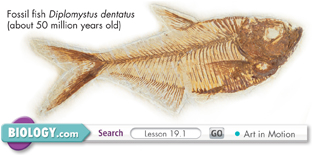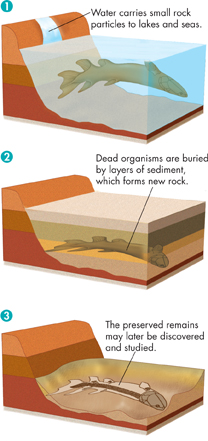Fossils in Sedimentary Rock Most fossils are preserved in sedimentary rock. Figure 19–2 shows how. 1 Sedimentary rock usually forms when small particles of sand, silt, clay, or lime muds settle to the bottom of a river, lake, ocean, or other body of water. Sedimentary rock can also form from compacted desert sands. 2 As sediments build up, they bury dead organisms that have sunk to the bottom. If the remains of these organisms are buried relatively quickly, they may not be scattered by scavengers. Usually, soft body structures decay quickly after death, so only wood, shells, bones, or teeth remain. These hard structures can be preserved if they are saturated or replaced with mineral compounds. Sometimes, however, organisms are buried so quickly that soft tissues are protected from aerobic decay. When this happens, fossils may preserve incredibly detailed imprints of soft-bodied animals and structures like skin or feathers.
3 As layers of sediment continue to build up over time, the remains are buried deeper and deeper. Over many years, water pressure gradually compresses the lower layers. This pressure, along with chemical activity, can turn the sediments into rock.
BUILD Vocabulary
WORD ORIGINS The words paleontology and paleontologist come from the Greek word palaios, meaning “ancient.” A paleontologist studies the remains of ancient life.
What Fossils Can Reveal Although the fossil record is incomplete, it contains an enormous amount of information for paleontologists (pay lee un TAHL uh jists), researchers who study fossils to learn about ancient life.  From the fossil record, paleontologists learn about the structure of ancient organisms, their environment, and the ways in which they lived. By comparing body structures in fossils—a backbone, for example—to body structures in living organisms, researchers can infer evolutionary relationships and form hypotheses about how body structures and species have evolved. Bone structure and footprints can indicate how animals moved. Fossilized plant leaves and pollen suggest whether an area was a swamp, a lake, a forest, or a desert. Also, when different kinds of fossils are found together, researchers can sometimes reconstruct entire ancient ecosystems.
From the fossil record, paleontologists learn about the structure of ancient organisms, their environment, and the ways in which they lived. By comparing body structures in fossils—a backbone, for example—to body structures in living organisms, researchers can infer evolutionary relationships and form hypotheses about how body structures and species have evolved. Bone structure and footprints can indicate how animals moved. Fossilized plant leaves and pollen suggest whether an area was a swamp, a lake, a forest, or a desert. Also, when different kinds of fossils are found together, researchers can sometimes reconstruct entire ancient ecosystems.
 In Your Notebook Construct a flowchart to explain how the remains of a snail might become fossilized in sedimentary rock.
In Your Notebook Construct a flowchart to explain how the remains of a snail might become fossilized in sedimentary rock.

FIGURE 19–2 Fossil Formation Most fossils, like the fish shown here, form in sedimentary rock. Interpret Photos What part of the fish has been preserved as a fossil?
Table of Contents
- Formulas and Equations
- Applying Formulas and Equations
- Mean, Median, and Mode
- Estimation
- Using Measurements in Calculations
- Effects of Measurement Errors
- Accuracy
- Precision
- Comparing Accuracy and Precision
- Significant Figures
- Calculating With Significant Figures
- Scientific Notation
- Calculating With Scientific Notation
- Dimensional Analysis
- Applying Dimensional Analysis





